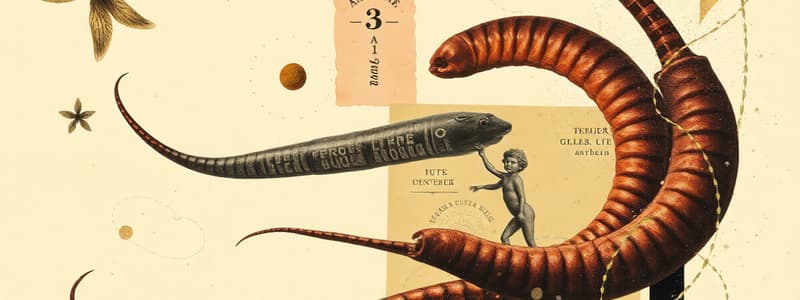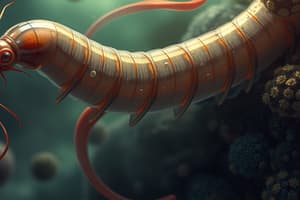Podcast
Questions and Answers
What adaptation do some leeches possess that aids in blood feeding?
What adaptation do some leeches possess that aids in blood feeding?
- Nephridia for efficient waste removal
- Setae for anchoring to the host
- Bladelike jaws to slit skin (correct)
- Parapodia for enhanced movement
How do earthworms utilize their hydrostatic skeleton for movement?
How do earthworms utilize their hydrostatic skeleton for movement?
- By using setae to anchor themselves and push against the fluid-filled coelom. (correct)
- By contracting muscles against a rigid exoskeleton.
- By coordinating the movement of parapodia in each segment.
- By employing a closed circulatory system to pump hemolymph.
Which characteristic is unique to the class Insecta within the phylum Arthropoda?
Which characteristic is unique to the class Insecta within the phylum Arthropoda?
- An open circulatory system
- Jointed appendages
- An exoskeleton composed of chitin
- Three body regions: head, thorax, and abdomen (correct)
Spiders belong to which class of arthropods, characterized by having two main body parts and mostly being terrestrial?
Spiders belong to which class of arthropods, characterized by having two main body parts and mostly being terrestrial?
What role do parapodia play in marine segmented worms (Polychaetes)?
What role do parapodia play in marine segmented worms (Polychaetes)?
What is the primary function of nephridia in annelids like earthworms?
What is the primary function of nephridia in annelids like earthworms?
What is a key difference between complete and incomplete metamorphosis in insects?
What is a key difference between complete and incomplete metamorphosis in insects?
What is the primary adaptation of spiders that allows them to capture prey?
What is the primary adaptation of spiders that allows them to capture prey?
Which characteristic is common to both millipedes and centipedes?
Which characteristic is common to both millipedes and centipedes?
How does the circulatory system of annelids, like earthworms, differ from that of arthropods?
How does the circulatory system of annelids, like earthworms, differ from that of arthropods?
What is the primary distinction between centipedes and millipedes in terms of their feeding habits?
What is the primary distinction between centipedes and millipedes in terms of their feeding habits?
What is the role of hirudin, produced by leeches, in their parasitic feeding behavior?
What is the role of hirudin, produced by leeches, in their parasitic feeding behavior?
How does sexual reproduction occur in insects, such as in the Insecta class?
How does sexual reproduction occur in insects, such as in the Insecta class?
What is the composition of the exoskeleton of arthropods?
What is the composition of the exoskeleton of arthropods?
What is the ecological role of freshwater nematodes?
What is the ecological role of freshwater nematodes?
Flashcards
Phylum Annelida
Phylum Annelida
Segmented worms, including earthworms, polychaetes, fan worms, and leeches.
Hermaphroditic
Hermaphroditic
Having both male and female reproductive organs.
Nephridia
Nephridia
Rudimentary excretory organs in annelids, filtering waste.
Hydrostatic skeleton
Hydrostatic skeleton
Signup and view all the flashcards
Closed circulatory system
Closed circulatory system
Signup and view all the flashcards
Setae
Setae
Signup and view all the flashcards
Parapodia
Parapodia
Signup and view all the flashcards
Hirudin
Hirudin
Signup and view all the flashcards
Phylum Nematoda
Phylum Nematoda
Signup and view all the flashcards
Trichinella
Trichinella
Signup and view all the flashcards
Exoskeleton (chitin)
Exoskeleton (chitin)
Signup and view all the flashcards
Jointed appendages
Jointed appendages
Signup and view all the flashcards
Open circulatory system
Open circulatory system
Signup and view all the flashcards
Insect Body Plan
Insect Body Plan
Signup and view all the flashcards
Metamorphosis
Metamorphosis
Signup and view all the flashcards
Study Notes
- Invertebrates are the focus
Phylum Annelida
- Includes segmented worms like earthworms, polychaetes, fan worms, and leeches
- Characterized by having a true coelom and segmented bodies
- Sensory organs are concentrated near the anterior end
Earthworms
- Terrestrial and freshwater segmented worms
- Setae are present for movement
- They are hermaphroditic, possessing both sexes
- They have rudimentary excretory systems known as nephridia
- They utilize hydrostatic skeletons for movement
- They possess a closed circulatory system
Marine Segmented Worms
- Have a well-developed head
- Have parapodia that function in locomotion on each segment
- Most are marine, tube-dwelling, and free-living
- Parapodia are richly supplied with blood vessels and can function as gills
Leeches
- Mostly inhabit fresh water, but some can be found on moist land
- Most feed on invertebrates, some are blood-sucking parasites
- Some use bladelike jaws to slit skin, while others use enzymes to digest a hole in the skin
- Hirudin keeps blood from coagulating
- Leeches can be used for treating bruised tissues and stimulating circulation of blood to fingers or toes that have been sewn back on after accidents
Polychaetes
- Polychaetes have a complete digestive tract
- They reproduce sexually, and sexes are separate
Phylum Nematoda
- Includes roundworms, pinworms, hookworms, and nematodes
- They are non-segmented
- Some are free-living, while others are parasites
General Characteristics
- Exoskeleton composed of chitin
- Have jointed appendages
- Possess an open circulatory system
- Gills for aquatic species, while terrestrial species have tracheal systems
Class Insecta-Insects
- One or two pairs of wings
- Body has three regions (head, thorax and abdomen)
- One pair of antennae, two compound eyes, several pairs of appendages surround the mouth
- On the thorax have 3 pairs of walking legs
- Sexes are separate and sexual reproduction occurs
- Most insects undergo metamorphosis during development
- The nervous system includes two nerves fused into a cerebral ganglion
Incomplete Metamorphosis
- Egg becomes nymph and then adult
- Nymph looks like the adult but lacks wings
Complete Metamorphosis
- Caterpillar (butterfly), maggot (fly) or grub (beetle) looks entirely different from adult
- Egg becomes larva then pupa and then adult
Class: Arachnida
- Includes spiders, scorpions, ticks, and mites
- Body has two main parts
- Six pairs of appendages consisting of 1 pair of chelicerae, 1 pair of pedipalps, and four pairs of walking legs
- Mostly terrestrial
- Spiders have book lungs (stacked plates) abdominal glands and spun by spinnerets
- Spiders produce silk, a protein
Class: Myriapoda
- Includes Millipedes & Centipedes
Millipedes
- Have two pairs of legs per segment
- Live on decaying leaves and other plant matter
Centipedes
- Terrestrial carnivores
- Appendages modified into mouthparts
- Each segment has one pair of walking legs
- Have poison claws on the anterior most end
Class: Crustacea
- Includes Crabs, lobsters, crayfish, shrimp
- Have multiple specialized appendages
- Have two pairs of antennae
- Have three or more pairs of appendages on the mouth
- Walking legs on thorax and abdomen
- Have gills for respiration
- Open circulatory system
- Separate sexes, larvae are planktonic
Studying That Suits You
Use AI to generate personalized quizzes and flashcards to suit your learning preferences.




